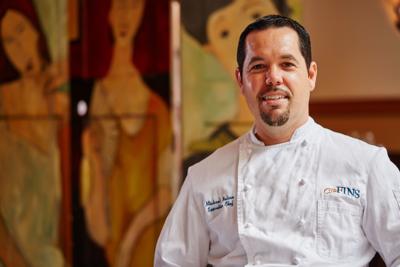Chef Michael Nelson doesn’t like seeing good parts of a fish tossed in the trash. Nelson has spent 14 years at GW Fins, the last four as executive chef, and its kitchen handles 700 to 1,000 pounds of fish per day. A few years into his tenure, Nelson realized that only 20% to 40% of each fish made it onto a plate. The rest went into the garbage.
That waste fueled his commitment to using more of the fish. He also believed some of the neglected parts were among the tastiest and made it his mission to introduce them to a broader audience.
Nelson will highlight the neglected parts of fish in a “Beyond the Filet” dinner at GW Fins Sept. 24. Dishes include blackened grouper cheeks and Vietnamese-glazed fin “wings.” The event is the latest in his campaign to rally more chefs, fishmongers and consumers to the idea of wasting less fish.
“Chefs have created this idea that fish should be this perfectly square boneless thing, served perfectly seared,” Nelson says. “It really has very little to do with the way fish are shaped and meant to be eaten.”
GW Fins began buying exclusively whole fish from its suppliers, eschewing precut fillets, five years ago. This practice is rare among restaurants because it requires substantial space, time and effort, Nelson says. One or two staff spend 10 to 15 hours a day butchering whole fish at GW Fins, but the rewards are fresher fish, less waste and the ability to create new dishes, Nelson says.
“I decided a long time ago the only way to really decide how fresh a fish is, is to see the whole fish,” Nelson says. “You can look at its gills, in its eyes, and tell how long it’s been (since it was) gutted. When you’re getting a fillet, you’re kind of guessing.”
Nelson and likeminded colleagues, including chefs Ryan Prewitt from Peche and Dana Honn from Carmo, are working to build enthusiasm and expertise around parts once considered castoffs. A few years ago, Nelson helped organize a fish boucherie. Several local chefs visited a fishing tournament where they demonstrated new techniques of whole fish butchery to the fishermen and cooked the leftover parts for them.
This summer Nelson brought a group of chefs to a local fish house for a closeup view of the waste. “It was really eye opening for a lot of people,” Nelson says. “You go back to where they put all the vats of the cut carcasses, and they were shocked to see the amount of meat left on these things, the potential that was there. The problem is a lack of knowledge of what is actually getting wasted.”
Nelson also has been training suppliers on butchery techniques to help GW Fins meet a growing demand for dishes showcasing less commonly used parts. Fins’ kitchen transforms fish scales into a gelatin that forms the base of a “sheepshead cheese,” a sliceable loaf similar in spirit to its hog-based counterpart. Nelson compares crispy fried fins to potato chips and extols the meat surrounding a fish’s collar, cheek and eye.
He also hopes to convert more diners into fans of his favorite ingredient: a well-cooked fish head.
“At first they’re kind of freaked out by it, but typically it’s their favorite thing they’ll have.”
Nelson notes that many cultures use the whole fish without reservation. The preference for tidy boneless fillets is a recent North American phenomenon.
“Over time, hopefully we will have people coming in and saying, ‘Hey, where are the fish heads?’” Nelson says. “I’m waiting. It’s coming.”
Beyond the Filet is a five-course dinner with wine pairings at 6:30 p.m. Tuesday, Sept. 24. It costs $95 per person, including tax and tip.


